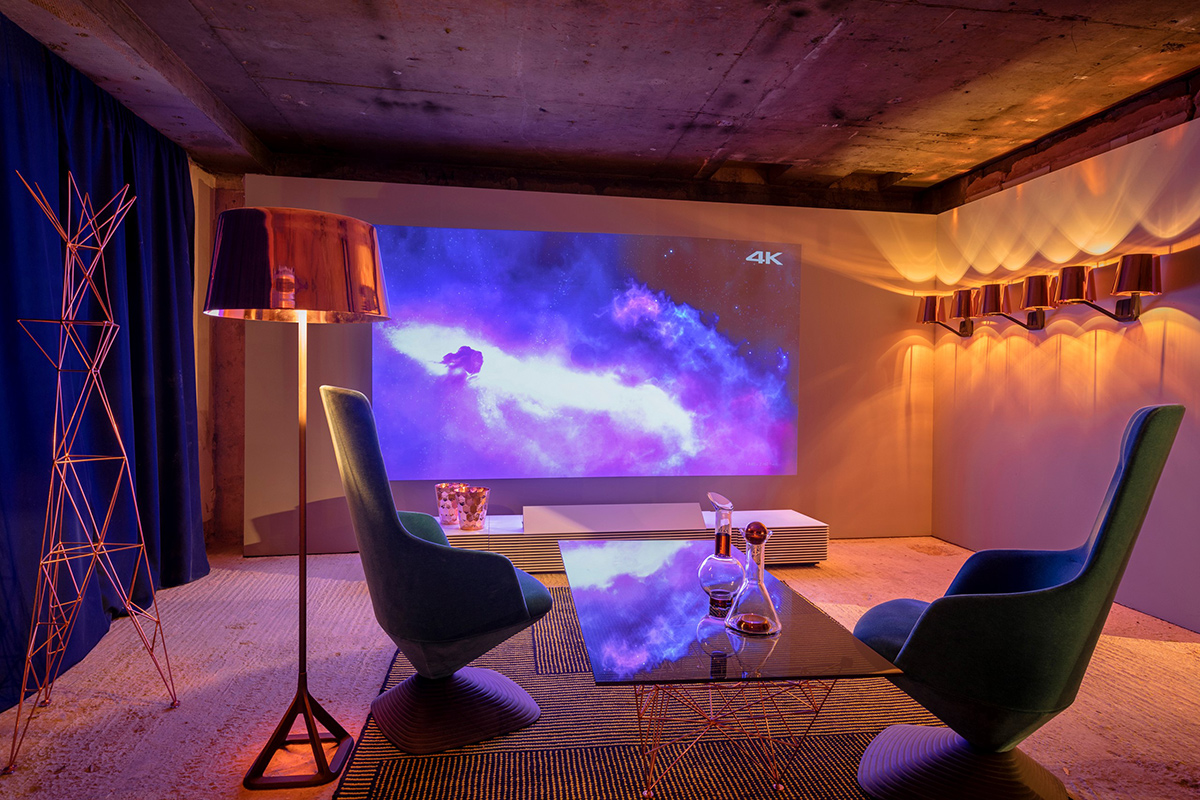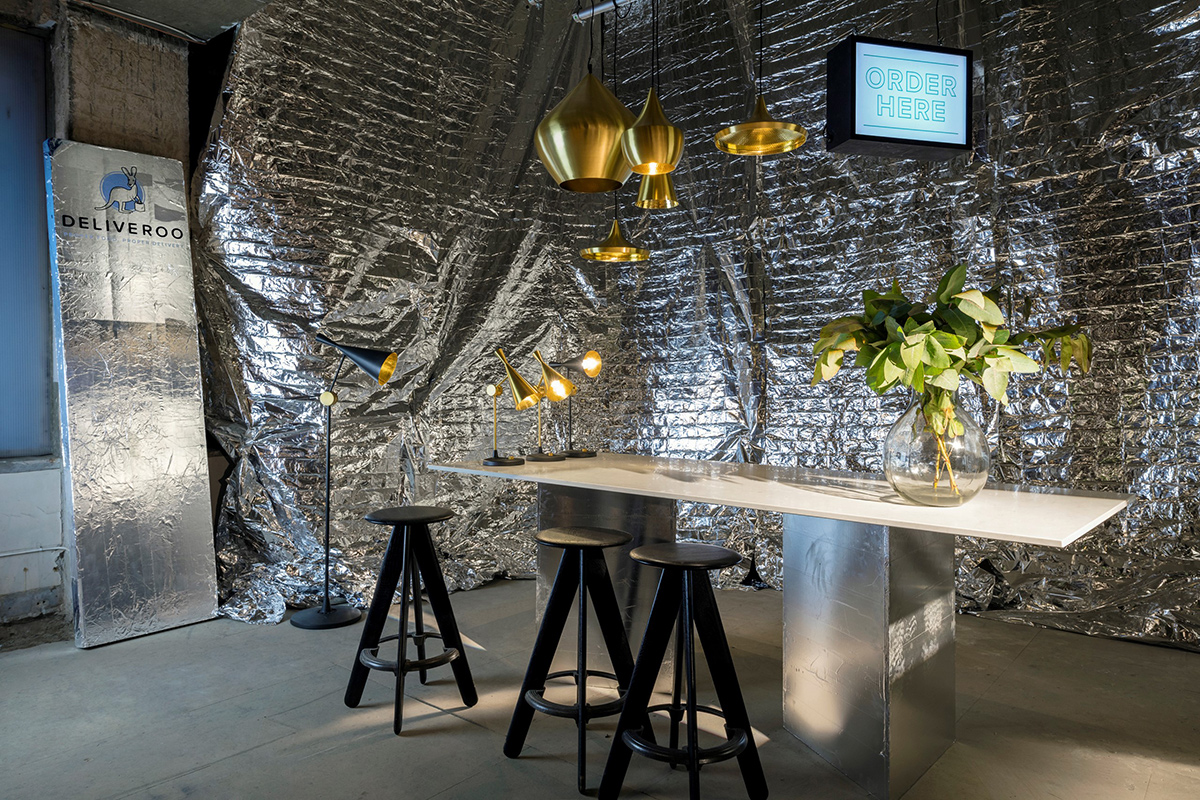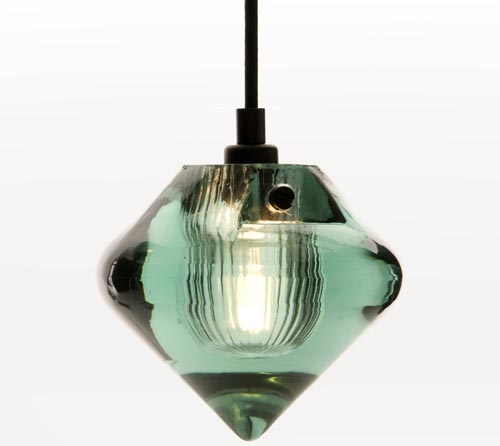London Design Festival 2015: Tom Dixon’s Multiplex
We speak with the designer at multi-sensory retail pop-up about his aversion to becoming static

Tom Dixon is a man with lots on his plate—and chances are it’s a plate he designed himself. The British designer is something of a Renaissance man: his company not only has its own restaurant, but it’s now also designing stationery and scented candles, has teamed up with Pierre Marcolini to create a luxurious chocolate box, and has launched a print magazine, called Tomorrow. Not to mention that Dixon also plays bass in the band Rough, which recently performed to a thrilled crowd at the Maison & Objet launch of his new Brew line. Now, he’s gone all-in and created a pop-up department store for the London Design Festival. It brings together 30 brands in a space that Dixon describes as “a parasite on the back of Selfridges, an adventure playground combined with a space station.”
Called Multiplex because of its layers, the store’s interior has a ”rugged London look” that also owes a debt to Andy Warhol’s Factory, with parts of the walls covered in silver foil. Among the brands are Swedish pocket synthesizer company Teenage Engineering, Sort of Coal, which promotes the benefits of White Charcoal, and Aston Martin, which is showcasing its DBX Concept at Multiplex. It’s an exciting new take on both the concept of a department store and the concept of a pop-up, and it looks fantastic. CH sat down and shared some pistachio ice cream with the designer, who was relieved to have pulled it all together, at the opening of Multiplex.

Last year at LDF you had a sale space, this year you’ve done almost the opposite and opened a department store?
Yeah, I am quite confusing, aren’t I? I think the worst thing you can do in the modern world is be static. We’ve got to a scale now where things have become slightly more possible—I mean, this was a bit of stretch, but I’ve always been slightly more interested in commerce than a lot of my contemporaries. I think for a lot of other designers, it’s something other people do, but I’ve never really separated out design and selling stuff. For me, designing things that people don’t like is beside the point. I like the idea of being present in lots of different ways. I’ve noted how people get very excited about sales and I quite like that energy, that kind of fever of affordability that a sale provides. But you don’t want to do a sale every design year; once is enough, right? So this is a slightly different departure point as well. I’m fascinated by the way that technology and communication nowadays allow us to be a lot more elastic and flexible in how we address our customers. And I think every brand has got to be slightly less rigid.
I think the worst thing you can do in the modern world is be static
How long has Multiplex been in the making?
It’s been eight weeks of hell. We tried to get Selfridges to do this for two years and they said no. Up until eight weeks ago they were promising us the carpark, so I was actually going to do a drive-in store, in the carpark—and then Anya Hindmarch got it… Some of the people that are here now just came on a few weeks ago, so that’s impressive—and I’m very happy.

How did you choose the other brands?
Well, it’s partially pragmatic: who would, in the last part of the year, be able to understand what we’re talking about? And then partially it’s strategic: I wanted to create departments that we could actually push beyond our own network, and find people in fashion and beauty that would be interesting. We thought a quite masculine brand, like ours, could benefit from a bit of softening up. It’s this whole idea of not preaching to the converted: I didn’t want to have the obvious contenders, and I like putting myself in slightly uncomfortable positions, which I really did this time. The discomfort level was like, “Oh my God, we’re never gonna pull this off” and all of the problems with the health and safety, security… So I think it’s so nice to be sitting here with you and an ice cream and not have to worry about it.
There’s a lot of digital aspects to Multiplex—how do you think the internet is changing design?
I think we’re in a stage where there is a little lull before an extraordinary change in manufacturing. From a design perspective, everything is possible in terms of the shapes you make, the smaller objects. I think we’re now just waiting for the more modern ways of manufacturing to become production ready. There are a lot of processes we use that have been computerized already—what’s interesting now is the proximity and potential for the designer to become a manufacturer and a distributor. I think that what it means for designers is that you end up much more in control of your own destiny than was ever possible before; it doesn’t matter whether that’s communicating new ideas, selling new ideas, manufacturing or designing them, those things are incredibly more possible than they were five, 10 or 20 years ago. The idea of addressing the whole world with a new product, you just couldn’t do it before. Obviously, in the process, you’ve got much more competition. If you’ve got that ability, so does everyone else, so somehow you have to work a bit harder to be unique.

Is there a risk that the internet makes for more homogeneous designs—things get shared on Pinterest and end up influencing everyone?
Yes, I think that’s a massive danger—that’s why it’s always interesting to go beyond just product design. It’s thrilling to see what people do with sugar and charcoal, materials in other trades. There’s a kind of vegetable soup emerging in design of everything starting to look like it’s been processed in the same way. But the clever designers, the innovative designers, have got lots of new things at their disposal to be unique. There’s also a lot of scope, particularly in product design. The great brands, like Vitra, Capellini, Moroso, are all using a stable of designers that have distinct ideas, but by the time it’s all under one umbrella, they get kind of mixed up a bit in terms of the aesthetic.

Tell us a bit about your interest in perishable designs—candles, chocolate, etc.
What I don’t want to do is become too expert, too specific. For instance, with smells: I spend a lot of time thinking about the colors in the space or the comfort of some furniture, and it’s been my observation for quite a while now that you might go into an amazing-looking restaurant and you might come out with a bad experience of the smell, and that’s what you remember. So smell, as a tool in your designer palette, as an interior decorator, suddenly becomes fascinating and something which requires an amount of expertise. The idea of designing through your nose, rather than your eyes, is freeing to me. Smell was one battle that we thought was worth fighting, and the next one will be sound. There’s the most appalling acoustic in most spaces, and that’s designing through your ears. I like the idea that as a designer, you’re more engaged than just making shapes. And the more you get into these things, the less there’s a distinction between them. Maybe the artificial separation between all these trades is kind of old fashioned.

And now you also gone into publishing, with the Tomorrow magazine?
It’s sort of a reflection of the same thing—there’s too many things to talk about, and I believe we can have a point of view which is distinct to other people. If we can subsidize and encourage new writing, new photography, new illustration through advertising, and have a broader discussion about interior design and urban design, I think that’s good for us. And we’ll see if the magazine survives as a point of view that other people want to buy into. When you talk about it, it’s oh my god, what the hell are we doing—not only trying to be food designers and smell designers, but also publishing designers… All of these are quite expert trades, but I think there’s always room for a strong point of view. Whether it can survive as a printed journal at a time when all of those magazines are under pressure anyway is another thing, but I like the experiment.
Images courtesy of Peer Lindgreen












